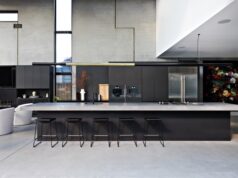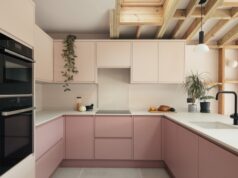
Kitchens can be a dangerous place for kids. Thankfully, there’s a lot you can do – even with an existing kitchen – to make your kitchen a safer place for children of all ages.

Kitchens, by virtue of all of the sharp blades, hot surfaces, electrical appliances and heavy moving parts they normally contain are usually a very dangerous place for young children in particular, thanks to their busy fingers and curious minds. There are many different devices that can be used to restrict access to danger areas like hot plates, and even a few different design considerations you can employ from the outset with child safety in mind.
A child safe kitchen needn’t look like a padded nursery – there’s no reason that a child-safe kitchen can’t be just as striking as any other kitchen.
Cabinets and drawer design
Revolving doors and cabinets where fingers can get stuck are perhaps the most obvious hazard, particularly because they conceal all kinds of interesting stuff that’s attractive to kids. Of course, soft closing drawers and hinges have a come a long way to reducing risks in general. Heavy doors are also likely to do damage, as are exposed hinges, so at the design stage it’s worth considering these things. Rounded corners and edges on cabinets will help reduce the chance of serious injury, as will using lighter materials rather than solid ones. If your kitchen has been designed with sharper corners, it’s possible to fit temporary soft, rounded corner pieces. Expect these to be chewed beyond recognition!
Locking mechanisms and preventing access
Cabinets and drawers with internal locking mechanisms like safety catches, internal latches and key card locks will all help to keep children out of cupboards and drawers, as will detachable handles. Some require cupboards and doors to open slightly in order to reach the latching mechanism – don’t underestimate how quickly children will learn how these work…
Special straps and latches can also be fitted to the outsides of cupboards which require a little strength to open – they may not look as nice but they’re very effective. Most of these measures can cheaply and easily be installed into existing kitchens with standard cabinet and drawer mechanisms, and they’re often sold as a complete kit.
Floor surfaces
Young children coming to terms with gravity and walking are particularly prone to slips and falls. Hard or slippery floors are also a danger for clumsy young kids. For this reason, hard concrete, stone or tile floors can be dangerous surfaces in kitchens (as much for adults as children, in fact). Vinyl flooring, linoleum flooring and floating floor are all more forgiving surfaces.
Glass and bench design
Kitchens with low glass must have safety glass installed, with a shatter resistant film placed over them. Benches with access to both sides, particularly if they are narrow, make it easier for children to reach whatever is on the bench. Tall, precarious stools can be a hazard too.
Powerpoints and electrical appliances
Where possible, powerpoints in kitchens should be installed up at bench level, out of reach of children. For those that aren’t, special powerpoint guards are available to protect them from being tampered with.
To keep children away from ovens, special oven guards also exist, which block off the oven altogether. Stovetop guards are also available which create a tall barrier over which children can’t reach and play with stove controls or burn themselves on hotplates or open gas flames.
There are countless many other measures that can help to make a kitchen safer for young children. If you expect to have young children in the house, consider these commonsense options, or discuss your choices with a kitchen designer.





